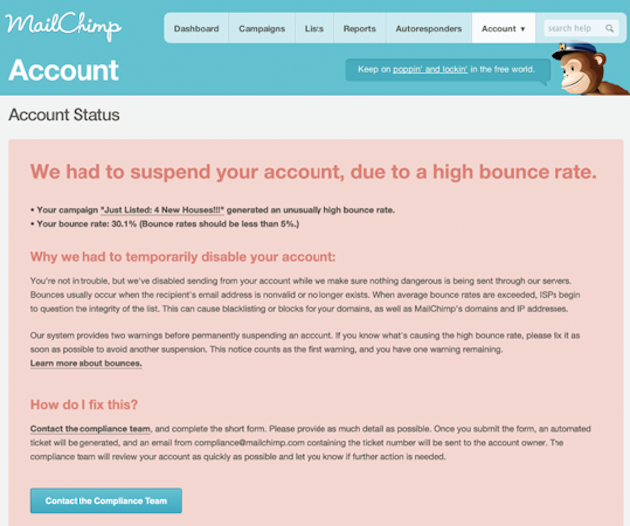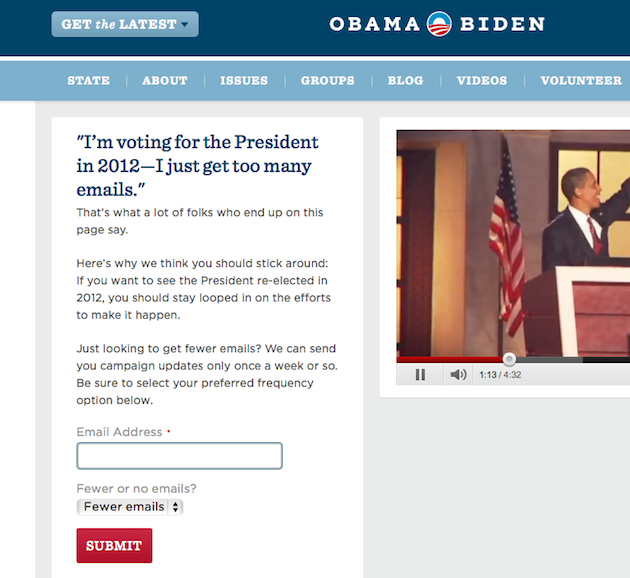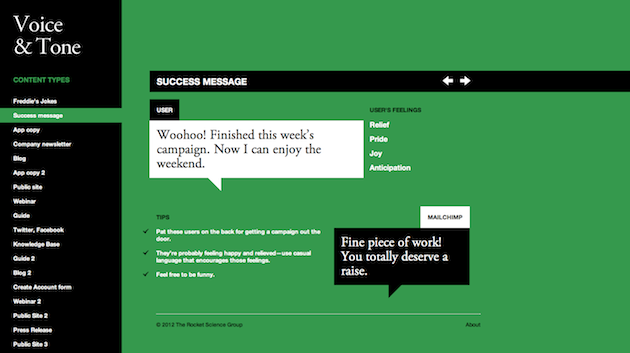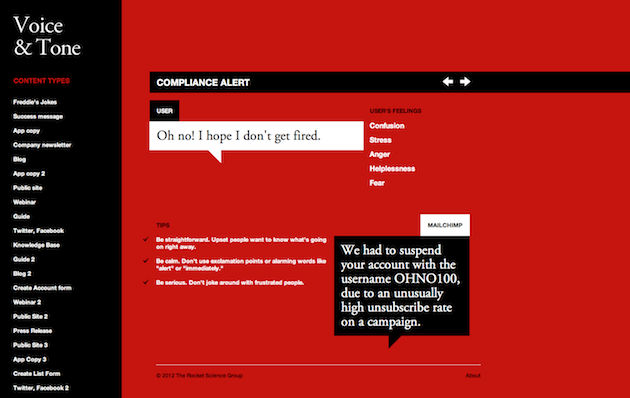Voice and tone. Tone and voice. Though the words “voice” and “tone” are often used interchangeably, they’re not synonyms. Our voice makes us unique, and our tone makes us sound like humans. Establishing a likable voice is critical for brands, but there’s more to it. Companies that acknowledge the distinction—maintaining a consistent voice and paying careful attention to their tone—publish more meaningful web content and build better relationships with their users.
Voice and tone. Tone and voice. Though the words “voice” and “tone” are often used interchangeably, they’re not synonyms. Our voice makes us unique, and our tone makes us sound like humans. Establishing a likable voice is critical for brands, but there’s more to it. Companies that acknowledge the distinction—maintaining a consistent voice and paying careful attention to their tone—publish more meaningful web content and build better relationships with their users.
What’s the bigger difference between voice and tone? Our company’s voice is an expression of personality, and it’s ingrained in every piece of content we publish. Our voice is who we are. Our brand’s voice naturally grows over time, but it generally stays the same from day to day. Our brand’s tone, on the other hand, should change often. Tone of voice is an adaptive reflection of feelings. Think of it in terms of your own voice and tone: You have only one voice, but you probably use a certain tone when you’re talking to friends or family, and an entirely different one with your boss or clients. You might use an extremely casual tone when you’re joking around with a friend, but a serious one when you’re consoling someone who’s upset. We instinctively adjust our tone in conversation, as an expression of empathy. But all too often, empathy is absent from web content. That’s why every company needs voice and tone standards—they help us understand our customers and show them respect.
One Voice
The first step is to find your brand’s voice. Where there’s a company, there’s usually a voice. Sometimes you have to dig it out from under a stinky pile of corporate lingo and SEO fodder, but put on your gloves, because it’s an important job. If we intend to connect with humans, our brand’s voice should probably sound human. So with that in mind, consult the humans who are closest to the heart of the company. Casual interviews help you get to the bottom of a brand’s voice quickly. This might mean talking to a founder, CEO, or communications manager. Maybe you want to interview someone from the customer-support team, or even the customers themselves. This kind of interview isn’t about gathering technical information, so give your subjects plenty of time to ramble, and listen for thoughtful responses. When you notice patterns, laughter, or other emotional reactions, dig deeper. Here are some helpful questions to ask (If you’re a one-person shop, why not ask yourself these questions?):
- What does your company do?
- Why do people visit your website?
- If your brand were a person, how would you describe him or her?
- How do you want people to feel when they visit your site?
Now you can start articulating a voice. Get it on paper. Describe the company’s personality in a way that feels human. There’s no right or wrong way: Pretend you’re explaining it to someone in a conversation, or write it like you’d describe a character in a novel, and see where that takes you.
A list of personality traits gives writers insight, but a “this but not that” list is twice as helpful. Zoom in on a description’s meaning by qualifying it with something that it’s not. At MailChimp, where I work, we’ve found this to be a reliable tool for writers and designers. Here’s our list:
MailChimp is:
- fun but not childish
- clever but not silly
- powerful but not complicated
- smart but not stodgy
- cool but not alienating
- informal but not sloppy
- helpful but not overbearing
- expert but not bossy
A “this but not that” list is a smart starting point for a voice and tone guide. You might want to add content types and explanations, specific copy examples, the company’s mission, or even user personas. Create voice guidelines that fit into your company’s culture. Keep in mind that just like a human’s voice, your brand’s voice will adapt and mature over time. Creating flexible voice guidelines makes it easy to revise and tweak them when the time is right.
Many Tones
When a company’s voice and tone stay exactly the same all the time, its content comes across as insincere and automated, and who wants to sound like a robot? Whether we’re writing for our own companies or working with clients, our tone should be flexible. Every time you publish something, adjust your tone based on:
- The content type/situation
- The user’s likely emotional state
In order to get inside the reader’s brain, you need to know what kind of content you’re writing in the first place, and what sort of situation that creates for the reader. Some content types (like success messages and marketing copy) lend themselves to a more lighthearted tone of voice, and others (like failure alerts and help documents) should be more straightforward. Determining your tone of voice requires predicting the reader’s emotional state. It’s an exercise in empathy; there’s nothing technical about this part of the process. To determine your tone of voice, consider these questions:
- What situation is the reader in at the moment?
- How does she feel right now?
- How is this content going to affect the reader?
- How can I maintain the reader’s state of mind or put her in a better one?
When a MailChimp user gets a campaign out the door, we send them a success message, which is basically a high five for a job well done. Most people who just sent a newsletter are feeling relieved, happy, and maybe even proud. So we use casual language that reflects and encourages those warm and fuzzy feelings. Here’s an example of a MailChimp success message.
But let’s be honest: Customers aren’t always happy when they’re interacting with our content. Sometimes we frustrate and disappoint our readers—and those people need to know we have their best interest at heart. When someone sends an email campaign that appears to be spam, MailChimp suspends the account and sends the customer a compliance alert. It basically says “We had to shut down your account because you were spamming.” It’s safe to assume that no one on the planet has ever been pleased to receive a compliance alert. Daily deal and e-commerce companies rely on email, and they lose money anytime a campaign is delayed. It’s bad news. We have to be sensitive to those users, who are probably feeling confused and stressed. We don’t make jokes here, and we explain the situation in a straightforward and clear tone—just as we would in a face-to-face conversation with someone who’s upset.
Touchy Subjects
Tone of voice can make or break your content, especially when you’re dealing with subjects that are sensitive for your readers. Be especially empathetic to the user’s needs and feelings when you’re writing about:
Health and medicine: If someone’s visiting a hospital or hospice’s website, there’s a good chance they already feel vulnerable or sad. Too much humor might give them the impression that you don’t understand what they’re going through. On the other hand, extreme formality might make them feel uncomfortable and alone. It’s best to strike a positive but understanding tone, somewhere in the middle of the formality scale.
Religion and politics: This one goes without saying. People hold religious and political beliefs close to their hearts, so it’s never a good idea to make light of those topics.
Money and private information: If you want customers to trust your company with their credit-card or personal information, you might want to keep the comedy out of your microcopy.
Those examples just scrape the surface. Everyone’s got touchy subjects, and it’s our job to predict them when we can. Watch your tone of voice in situations where a user is troubleshooting, reporting a problem, reading about a sensitive topic, or failing at a task. These content types are particularly sensitive:
- Help docs
- FAQ and contact pages
- Forms
- Legal and privacy information
- Failure messages and alerts
- Unsubscribe screens
People who see your newsletter unsubscribe screen probably aren’t your biggest fans–after all, they did say they never want to receive email from you again. Generic content won’t convince those subscribers to stick with you, and flippancy isn’t going to help either. The Obama campaign understands that tone of voice is vital in situations like these. When a reader clicks to unsubscribe from the campaign’s newsletter, here’s what they see:
This message strikes a nice tone. Not only does it imply that they know how the reader feels, but it validates those feelings and offers a reasonable compromise: receive fewer emails. The campaign’s understanding tone of voice probably helps them retain a lot of subscribers that were a few seconds away from ditching the newsletter.
You can do it
Voice and Tone is an interactive guide made for MailChimp’s writers, based on the reader’s emotional state at any given time. We share a list of our content types, alongside tips and examples for communicating based on each of those types. The color of the screen loosely reflects the customer’s emotional state when they’re interacting with a particular type of content, moving from green (for the happy end of the emotional spectrum) to red (for the more heated emotions). Here’s the screen for success messages:
And here’s the compliance alert screen:
MailChimp’s Voice and Tone site isn’t just a practical guide; it’s an experimental project, so we spent quite a bit of time and resources developing it. But voice and tone work doesn’t necessarily demand a lot of time or vast resources. The only requirement is basic human empathy. A Google doc, a wiki page, or a simple file in a project-management program might be the best format for your company’s voice and tone guidelines. MailChimp’s guide is required reading for staff members, because at the end of the day, every employee is communicating on behalf of the company in some way.
Voice and tone evaluation should be built into a company’s content strategy, publishing, and UX processes. It’s crucial to our content, and it shouldn’t be treated as an extra step or optional add-on. Empathetic content makes it possible for us to connect with our readers on a human level. And treating our readers like humans improves more than our content—it improves our culture.
Trumpet photo courtesy Shutterstock









